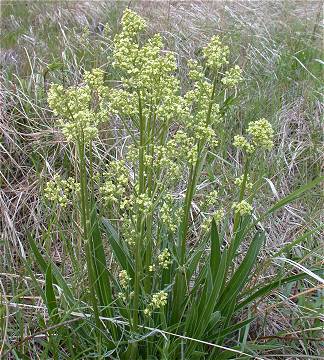

Valeriana ciliata - (image 1 of 7)
Taxonomy
Family: Valerianaceae
Some authorities consider this to be a variety of Valeriana edulis and call it V. edulis Nutt. ex Torr. & A. Gray var. ciliata (Torr. & A. Gray) Cronquist
Habitat
Prairies, calcareous fens. Swamps and wet open soil.
Associates
When Cypripedium candidum occurs in prairies this species is usually found with it along with Zizia aurea.
Distribution
Central OH and southern Ontario west to MN and IA. Valeriana edulis occurs in the western cordilleran region from British Columbia to Mexico.
Morphology
Perennial to 1.2 m from a long stout taproot and branched caudex. Leaves thick, almost parallel-veined, densely ciliate; basal leaves linear oblanceolate, to 30 cm, entire or rarely with 1-2 basal divisions; cauline leaves pinnately divided into a few segments from a broad, flat rachis. Inflorescence elongate, terminal, paniculate; plants polygamo-dioecious; corolla of perfect or staminate flowers to 3.5 mm, that of pistillate flowers usually less than 1 mm; fruit ovate or ovate-oblong, 3-4 mm.
Notes
Flowers late April to early June
Wetland indicator: Obligate
The flowers smell very nice. These caterpillars seem to think they taste good too. Valeriana edulis is similar but mostly glabrous and occurs in western North America.
References
Gleason, Henry A. and A. Cronquist. 1991. Manual of Vascular Plants of
Northeastern United States and Adjacent Canada. Second Ed.
The New York Botanical Garden. Bronx, NY
Swink, F. and G. Wilhelm. 1994. Plants of the Chicago Region.
Indiana Academy of Science. The Morton Arboretum. Lisle, Illinois.
|
Michael Hough © 2005 |